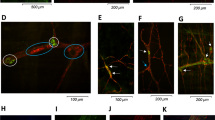Summary
An ultrastructural and stereological examination was performed on stomach smooth muscle of the salamander Amphiuma. This tissue has very large cells, ranging up to 12×1500 μm when relaxed. The extracellular space is 31% of the tissue volume, and the tissue contains 84.6% water. These values are similar to those of other amphibian and mammalian gastrointestinal smooth muscle. The cells possess the usual smooth muscle organelles. Thick, thin and intermediate filaments are present, along with membrane-associated and cytoplasmic dense regions. There is a well-developed sarcoplasmic reticulum and many microtubules. Caveolae are found in rows along the cellular surface; the caveolae increase the cellular surface area by about 70%. The ratio mean volume: surface area of the cells is 1.26 μm. This tissue appears to be typical of gastrointestinal smooth muscle, with the exception of the very large size of the cells.
Similar content being viewed by others
References
Armstrong WM (1964) Sodium, potassium, and chloride in frog stomach muscle. Am J Physiol 206:469–475
Bagby RM (1980) Double-immunofluorescent staining of isolated smooth muscle cells. Histochemistry 69:113–109
Bagby RM, Fisher BA (1973) Graded contractions in muscle strips and single cells from Bufo marinus stomach. Am J Physiol 225:105–109
Bagby RM, Young AM, Dotson RS, Fisher BA, McKinnon K (1971) Contraction of single smooth muscle cells from Bufo marinus stomach. Nature 234:351–352
Barr L, Malvin RL (1965) Estimation of extracellular spaces of smooth muscle using different-sized molecules. Am J Physiol 208:1042–1045
Bossen EH, Sommer JR, Waugh RA (1978) Comparative stereology of the mouse and finch left ventricle. Tissue Cell 10:773–784
Burnstock G, Dewhurst DJ, Simon SE (1963) Sodium exchange in smooth muscle. J Physiol 167:210–228
Caffrey JM, Anderson NC Jr (1978) Isolation of smooth muscle cells from Amphiuma stomach. Fed Proc 37:639
Casteels R, Droogmans G, Hendrickx H (1971) Membrane potential of smooth muscle cells in K-free solution. J Physiol 217:281–295
Devine CE, Somlyo AV, Somlyo AP (1972) Sarcoplasmic reticulum and excitation-contraction coupling in mammalian smooth muscle. J Cell Biol 52:690–718
Eisenberg BR (1982) Quantitative ultrastructure of mammalian skeletal muscle. In: Peachy LD, Adrian R (eds) Handbook of physiology, skeletal muscle. Washington D C. American Physiological Society, pp 73–112
Eisenberg BR, Kuda AM, Peter JB (1974) Stereological analysis of mammalian skeletal muscle. I. Soleus muscle of the adult guinea pig. J Cell Biol 60:732–754
Fay FS, Shlevin HH, Granger WC Jr, Taylor SR (1979) Aequorin luminescence during activation of single isolated smooth muscle cells. Nature 280:506–508
Gabella G (1976) Quantitative morphological study of smooth muscle cells of the guinea-pig taenia coli. Cell Tissue Res 170:161–186
Gabella G (1979) Cell junctions and structural aspects of contraction. Br Med Bull 35:213–218
Goodford PJ, Hermansen K (1961) Sodium and potassium movements in the unstriated muscle of the guinea pig taenia coli. J Physiol 158:426–448
Goodford PJ, Wootton GS (1975) A reassessment of the ratio between cell volume an cell surface area in the smooth muscle of the guinea-pig taenia coli. In: Worcel M, Vassort G (eds) Smooth muscle physiology and pharmacology. INSERM, Paris, pp 405–414
Heidlage JF, Anderson NC Jr (1980) Ultrastructure of Amphiuma stomach smooth muscle. Fed Proc 39:2170
Jones AW, Somlyo AP, Somlyo AV (1973) Potassium accumulation in smooth muscle and associated ultrastructural changes. J Physiol 232:247–273
McIver DJL, MacKnight ADC (1974) Extracellular space in some isolated tissues. J Physiol 239:31–49
Merrillees NCR (1968) The nervous environment of individual smooth muscle cells of the guinea pig vas deferens. J Cell Biol 37:794–817
Merz WA (1968) Streckenmessung an gerichteten Strukturen im Mikroskop und ihre Anwendung zur Bestimmung von Oberflächen-Volumen-Relationen im Knochengewebe. Mikroskopie 22:132–142
Nonomura Y (1968) Myofilaments in smooth muscle of guinea pigs taenia coli. J Cell Biol 39:741–745
Perry SV, Grand RJA (1979) Mechanisms of contraction. Br Med Bull 35:219–226
Somlyo AP, Somlyo AV (1975) Ultrastructure of smooth muscle. In: Daniel EE, Paton DM (eds) Methods in pharmacology, vol III, Smooth muscle, Plenum Press, New York, pp 3–45
Somlyo AP, Somlyo AV (1977) Ultrastructure and contractile apparatus: controversies resolved and questions remaining. In: Casteels R, Godfraind T, Reugg JC (eds) Excitation-contraction coupling in smooth muscle, Elsevier/North Holland, New York, pp 317–322
Spurr AR (1969) A low viscosity epoxy resin embedding medium for electron microscopy. J Ultrastruct Res 26:31–43
Stephenson EW (1967) Cation regulation in the smooth muscle of frog stomach. J Gen Physiol 50:1517–1546
Weibel ER (1980) Stereological methods. II. Theoretical foundations. New York, Academic Press, pp 264–311
Weibel ER, Bolender RP (1973) Stereological techniques for electron microscopic morphometry. In: Hayat MA (ed) Principles and techniques for electron microscopy. Biological applications. vol 3, Van Nostrand Reinhold, New York, pp 237–296
Weibel ER, Knight BW (1962) A morphometric study on the thickness of the pulmonary air-blood barrier. J Cell Biol 21:367–384
Author information
Authors and Affiliations
Additional information
We would like to thank Dr. Laz Mandel, in whose lab the PEG experiments were performed, and Steve Soltoff, who helped with those experiments. Thanks are also due to Dr. Peter Lauf for use of his beta counter. This project was supported by NIH grants F32 AM 05926 and AM 27819.
Rights and permissions
About this article
Cite this article
Heidlage, J.F., Anderson, N.C. Ultrastructure and morphometry of the stomach muscle of Amphiuma tridactylum . Cell Tissue Res. 236, 393–397 (1984). https://doi.org/10.1007/BF00214243
Accepted:
Issue Date:
DOI: https://doi.org/10.1007/BF00214243




